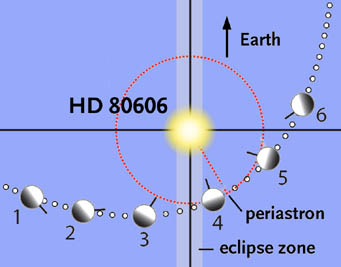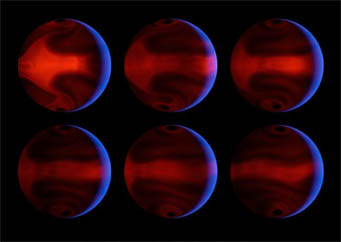Valentine's Day this year brought a big surprise from 190 light-years away: the unlikely transit of an unusual planet. Beyond the novelty, scientists may have spotted a hot Jupiter in the making.
Transits occur when a planet passes in front of the disk of its host star as seen from Earth. Transiting exoplanets are particularly important because they reveal the size and mass of a planet, which enables astronomers to infer their compositions.

When the Spitzer Space Telescope observed HD 80606b in November 2007, the alien planet briefly ducked behind its host star.
G. Laughlin (UCSC) & others / Nature
This particular transiting exoplanet, HD 80606b, was discovered in 2001 by the way its gravity perturbs its star. But until a few months ago, scientists had mostly given up hopes of seeing the planet transiting. In November 2007 a team led by Greg Laughlin (University of California, Santa Cruz) caught the planet disappearing behind its star, an event known as a secondary eclipse. This observation meant the orbit of HD 80606b is seen edge-on or nearly edge-on from Earth. Laughlin estimated that the planet had a one-in-seven chance of passing in front of its star on February 14th this year.
Amateurs and professionals around the world spent the eve of Valentine's Day looking at the host star, HD 80606. Laughlin filtered reports through his blog at oklo.org. Some of the views were obstructed by clouds, other astronomers enjoyed clear skies but saw no signs of a transit. Then last week, three groups submitted papers reporting transit detections.
HD 80606b orbits its star every 111 days. Previously, no transit had been observed for a planet with a period longer than 21 days, so HD 80606b smashes the record for the transiting exoplanet with the longest orbital period. This will help astronomers fill in the gap between most transiting exoplanets, which are hot Jupiters with very short orbital periods of a few days, and our own Jupiter, which takes nearly 12 years to orbit the Sun.
Among the observers was a group at University College London, UK, involving undergraduate students, which used 35cm and 25cm Celestron and Meade telescopes outside London. The group, led by Stephen Fossey, measured how much the light from the sun-like star HD 80606 was dimmed when its orbiting planet HD 80606b was in the line of sight. This yielded the planet’s radius: similar to that of Jupiter. But the planet is four times Jupiter’s mass, meaning it is a much denser world than our solar system’s gas giants, with a higher concentration of heavy elements.
With two telescopes of 1.93 meters and 1.2 meters in southern France, a team led by Claire Moutou (Provence University in Marseille, France), used more advanced techniques. While their result still awaits confirmation, they noticed that the planet’s orbit may be inclined by a large angle with respect to the star's equator.

Computer simulations show how the night side of exoplanet HD 80606b radiates away heat after a scorching pass near its parent star. The frames run from 4.4 days (upper left) to 8.9 days (lower right) after periastron.
NASA / JPL / J. Langton (UCSC)
Besides this misalignment, scientists already knew that HD 80606b had a very eccentric orbit, more like that of a comet. Its path brings it closer to its star than Mercury is to the Sun, and then it recedes nearly as far as Earth. As Laughlin and collaborators reported last month, this elongated trajectory causes an 800-fold variation in the intensity of light the planet receives form its star, leading to a few hours of intense heat, and nearly 111 days of relative cold.
This inclined and eccentric orbit is unusual. Most of the 50 or so known transiting exoplanets are Jupiter-like gas giants that are hot because they orbit their parent star at close range. But these hot Jupiters raise questions. Like other planets, gas giants are thought to form inside a disk around a newborn star, but far away from the star, like Jupiter and Saturn. So how does a gas giant get close to it star, orbiting it in a matter of days instead of 12 years for our own Jupiter?
One theory holds that some cold Jupiters migrate inward owing to the influence of a stellar binary companion. In the likely case that the second star lies off the plane of the disk giving birth to the planet, the star’s gravity would yank the planet’s orbit off that plane as well. And the planet then ends on an orbit that is eccentric and inclined relative to the initial disk, and thus to the equator of the host star.
This is what may have happened to HD 80606b. Within a few billion years, tidal forces exerted by the host star should cause the planet’s orbit to shrink to a more circular, tighter one, turning HD 806060b into a hot Jupiter. This won't happen with our own Jupiter, since unlike HD 80606, our Sun does not have a binary companion.
Still, the main news from this Valentine's Eve transit is that it occurs at all, and can be observed again and again with more powerful equipment. Astronomers will be ready for the next transit on June 5th, to learn more about the planet.
 0
0
Comments
You must be logged in to post a comment.